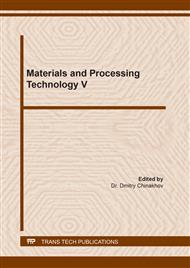[1]
O. V. Kuzovleva, Experimental Researches of Carbon Steels Plasticity Changes in the Field of Phase Transformations, IOP Conf. Series: Journal of Physics: Conf. Series. 1210 (2019) 012077.
DOI: 10.1088/1742-6596/1210/1/012077
Google Scholar
[2]
G. Pivnyak, R. Dychkovskyi, E. Cáceres Cabana, A. Smoliński, Determination of Plasticity for Pre-Deformed Billet, Solid State Phenomena. 291 (2019) 110-120.
DOI: 10.4028/www.scientific.net/ssp.291.110
Google Scholar
[3]
A. Zavdoveev, Ya. Beygelzimer, E. Pashinska, V. Grishaev, A. Maksakova, Drawing of the wire of low-carbon steel: plasticity resource, optimal reduction, structure, properties, Materials Science. (2014) 1-16.
Google Scholar
[4]
B.A. Migachev, Defining the parameters of the phenomenological model of limit deformations, Math. Russian Academy of Sciences. Metally. 2 (1997) 109-113.
Google Scholar
[5]
A. A. Bogatov, Features rheological behavior and fracture of metal at monotonic and alternating strain, Plastic deformation of steels and alloys. Coll. Scien. works. Ed. prof. A.V. Zinoveva. MISIS, Moscow, (1996).
Google Scholar
[6]
M.V. Markushev, On the methods of severe plastic deformation for bulk nanomaterials processing, Lett. Mater. 1 (2011) 36-42.
Google Scholar
[7]
I.S. Kodirov, G.I. Raab, G.N. Aleshin, A.G. Raab, D.V. Gunderov, N.K. Tsenev, Production of gradient structures in metals by means of severe plastic deformation, Bulletin of the Russian Academy of Sciences: Physics. 84 (2020) 508-511.
DOI: 10.3103/s1062873820050160
Google Scholar
[8]
G. Faraji, H. Kim, Review of principles and methods of severe plastic deformation for producing ultra fine-grained tubes, Materials Science and Technology. 33(8) (2017) 195-215.
DOI: 10.1080/02670836.2016.1215064
Google Scholar
[9]
R.B. Figueiredo, T.G. Langdon, Evaluating the Superplastic Flow of a Magnesium AZ31 Alloy Processed by Equal-Channel Angular Pressing, Metallurgical and Materials Transactions A: Physical Metallurgy and Materials Science. 8 (2013) 1-8.
DOI: 10.1007/s11661-013-1920-7
Google Scholar
[10]
W. Chrominski, M. Kulczyk, M. Siwek, M. Lewandowska, Tailoring microstructure and mechanical properties of 6063 aluminium alloy for lightweight structural parts, Materials Science Forum. 765 (2013) 388-392.
DOI: 10.4028/www.scientific.net/msf.765.388
Google Scholar
[11]
G. A. Salishcheva, R. M. Imayeva, O. N. Senkovb, V. M. Imayeva, N. K. Gabdullina, M. R. Shagieva, A. V. Kuznetsova, F. H. Froesb, Formation of a submicrocrystalline structure in TiAl and Ti3Al intermetallics by hot working, Materials Science and Engineering: A. 286 (2000) 236-243.
DOI: 10.1016/s0921-5093(00)00806-6
Google Scholar
[12]
Y. Estrin, A. Vinogradov, Extreme grain refinement by severe plastic deformation: A wealth of challenging science, Acta Mater. 61(3) (2013) 782-817.
DOI: 10.1016/j.actamat.2012.10.038
Google Scholar
[13]
M.V. Markushev, M.Yu. Murashkin. In: Aluminium Alloys. Their Physical and Mechanical Properties, DGM. 2 (2008) 1518.
Google Scholar
[14]
Patent RU N. 2557377. Multiradius rolling roller: Pat.no. 2557377 RUS. Federation. No. 2013135797/02; application 20.07.20153; publ. 27.05.2016, Byul. no. 27 (II CH.). 6 P.
Google Scholar
[15]
A. Krechetov, K. Mitrofanova, The Study of Multiradius Roller Running Process, MATEC Web of Conferences. 297 (2019) 05003-05008.
DOI: 10.1051/matecconf/201929705003
Google Scholar
[16]
V.Yu. Blyumenshtein, K.S. Mitrofanova, Study on effect of technological factors of surface plastic deformation process by complex-profile tool on quality of surface layer,Strengthening technologies and coatings. Publishing House Innovative Mechanical Engineering,. 182 (2020) 68-74.
Google Scholar
[17]
Ya. S. Umansky, Yu. A. Skakov, A. N. Ivanov, Crystallography, radiography and electron microscopy, Metallurgy, Moscow, (1982).
Google Scholar
[18]
S. S. Gorelik, Yu. A. Skakov, L. N. Rastorguev, Radiographic and electron-optical analysis: textbook. Manual for universities, MISIS, Moscow, (1994).
Google Scholar
[19]
L. I. Mirkin, Handbook of X-ray diffraction analysis of polycrystals, Moscow, (1961).
Google Scholar


